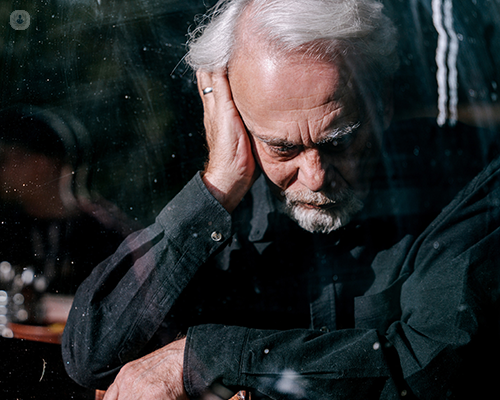Hearing loss (Part 1): Signs and Screening
Escrito por:Hearing loss is the reduction in hearing ability that occurs when electrical (sound) signals do not reach the brain. The loss of hearing can affect one or both ears, be temporary or permanent, and range in degree from mild to profound. Some types of hearing loss may be present at birth, whilst others develop later in life.
Mr Harry Powell is a leading consultant ENT surgeon who specialises in all aspects of hearing loss. In the first part of a two-part series on hearing loss, Mr Powell offers a comprehensive insight into the signs that indicate hearing problems in adults and children, and the main tests that are used in hearing loss assessments.

How many people develop hearing problems as they get older? At what age does this occur?
Hearing peaks during the late teenage years and early twenties, and declines progressively after. Around 53 per cent of the population between the ages of 71 to 80 will usually be affected by hearing impairment as they age.
Despite this, the age at which hearing loss develops (most commonly, sloping sensorineural hearing loss) can vary greatly, depending on an individual’s ageing and hereditary (genetic) degenerative process.
What difficulties might people with hearing loss experience? When is an assessment for hearing loss performed?
The progression of hearing problems is gradual and subtle, causing symptoms that may be troublesome for family or household members. These symptoms may include: having difficulties hearing conversations (especially when there is background noise), having to ask others to repeat their words or having to watch television with a louder volume.
People with hearing loss will generally be assessed with an otological history and examination. Some audiology services will admit direct referrals for pure tone audiometry and consideration of hearing aids - if there are normal tympanic membranes and no suspicious features - but if there is any doubt, a referral to the local ENT service will be advised instead, for specialist examination.
How accurate is it that the use of personal electronic devices has increased the prevalence of hearing problems? Can exposure to excessive noise affect hearing and if so, how?
The principal avoidable cause of hearing loss (both occupationally and recreationally) is noise exposure, which is also a leading factor for the onset of tinnitus.
Noise-caused hearing damage is connected to the volume and the duration of the noise exposure. Due to biological variability, every individual’s vulnerability to hearing damage is at different noise levels, but at present, the safe exposure limit for noise at an occupational level is 85 decibels for eight hours. Noise louder than 90 decibels can lead to permanent mechanical and metabolic damage, which will first affect the outer hair cells, then the inner hair cells and depending on the noise’s duration and intensity, changes will subsequently occur in the supporting pillar cells and the stria vascularis, which is a structure in the cochlea’s lateral wall. On an audiogram, noise damage will appear as a dip at four to six Hz.
Day-to-day activities like listening to music with excessive volume through headphones can lead to long-term damage to the cochlea, whilst using power tools or going nightclubbing subjects the ears to very loud noise. There is no data to suggest that listening to music at recommended volume levels can cause hearing loss later in life.
Damage to the cochlea occurs over time, and thus avoidance of noise exposure and the adoption of appropriate protective measures is key.
What are the signs of hearing loss in babies? What does the current screening programme for newborns consist of and is it aimed only at those infants who are at high risk?
Identifying whether a baby has hearing difficulties using simple observation or informal testing in surgery, is difficult. This is because infants and young children can look startled or react to sounds even if they have significant hearing problems that will affect their ability to learn to talk. However, if the babies’ parents are concerned, then there is a reason for investigation.
In the UK, all babies are offered a hearing screen after birth which is usually performed before their discharge from hospital. If a baby does not pass the hearing screen or is at a high risk of hearing loss, then he/she is referred to the hospital’s audiology department, where diagnostic testing will be carried out. There are some instances, however, in which families decide not to attend appointments even when their baby has not passed the hearing screen.
How reliable are hearing loss screening tests for children? Should all children for whom there is parental concern be referred?
Hearing loss screening tests for children are scheduled at separate intervals. The decision of which test to use depends on the child’s age, intellectual ability and motor capacity:
- Otoacoustic emissions for newborns
- Distraction techniques for babies who are seven months old
- Visual reinforcement audiometry or conditioned reflex audiology for children aged two to four years old
- Pure tone audiogram for children who are five years old or older
Hearing screening is very accurate in the identification of children who may have hearing loss and need further evaluation, as the newborn screen only identifies an issue with hearing that is present at birth and possible issues that will affect the baby’s development of spoken language. For this reason, children who have milder hearing problems may successfully pass the screen, but their development may still be affected. Permanent hearing loss can also develop in some children later in life as well as hearing loss due to persistent glue ear, a condition in which the empty middle ear becomes filled with sticky, glue-like fluid.
If parents are concerned, children should be referred for hearing assessments at all times. This should also be the case if the baby appears to ignore his/her parents or if the baby’s speech is not clear, something which can happen when quieter sounds are not heard. These signs may indicate a milder hearing loss which still requires medical attention.
Test reliability depends on the choice of an appropriate test and the child’s cooperation, but in general, a hearing test can be undertaken at any age.
In clinical practice, how beneficial are Weber’s and Rinne’s examinations? How often are these tests used?
The Weber and Rinne tests use tuning forks to establish whether hearing loss is conductive or sensorineural. This is based on two principles:
- In most cases, the inner ear is twice as sensitive to sound conducted by air (using ear structures) as opposed to bone conduction (which uses vibrations via bones).
- The ear is exposed to less environmental sound in exclusively conductive hearing loss cases and thus, is more susceptible to bone conduction.
Both tests require either a 256Hz or a 512Hz tuning fork to be used. This is because patients who have a hearing impairment may not pick up the sound of higher frequency forks and with a 128Hz fork, it is challenging to differentiate between hearing it and feeling its vibration.
To produce as much of a pure tone as possible, the ENT specialist should strike the tuning fork a third of the distance from its tip against a solid but flexible object (for example, the elbow). The tuning fork should be positioned two to three cm from the external meatus (ear canal) in the Rinne examination, with its acoustic axis in line with the external auditory canal.
Despite having low sensitivity and precision, the Weber and Rinne tests are a quick way to identify a patient’s type of hearing loss. The Weber test, in particular, is routinely performed post-operatively. On the other hand, in an ENT outpatient setting, the difference between conductive and sensorineural loss as well as the quantification of their magnitude is resolved with pure tone audiometry.
Head on over to the second part of this series to find out about the use of cochlear implants and hearing aids for hearing loss.
If you are experiencing, or have developed, hearing problems and you wish to seek expert assessment and treatment for them, don’t hesitate to visit Mr Powell’s Top Doctors profile today.


